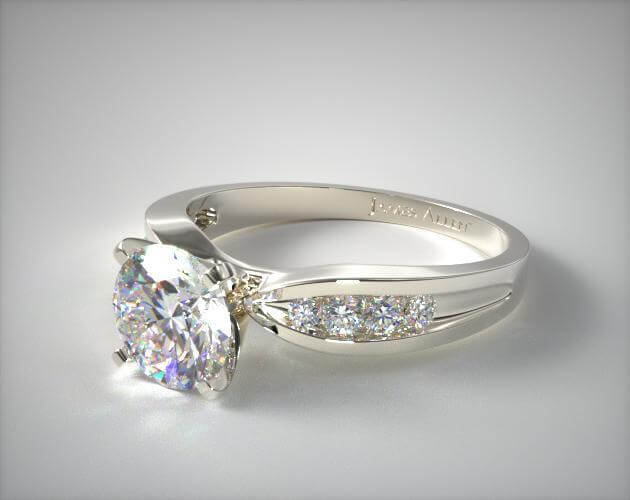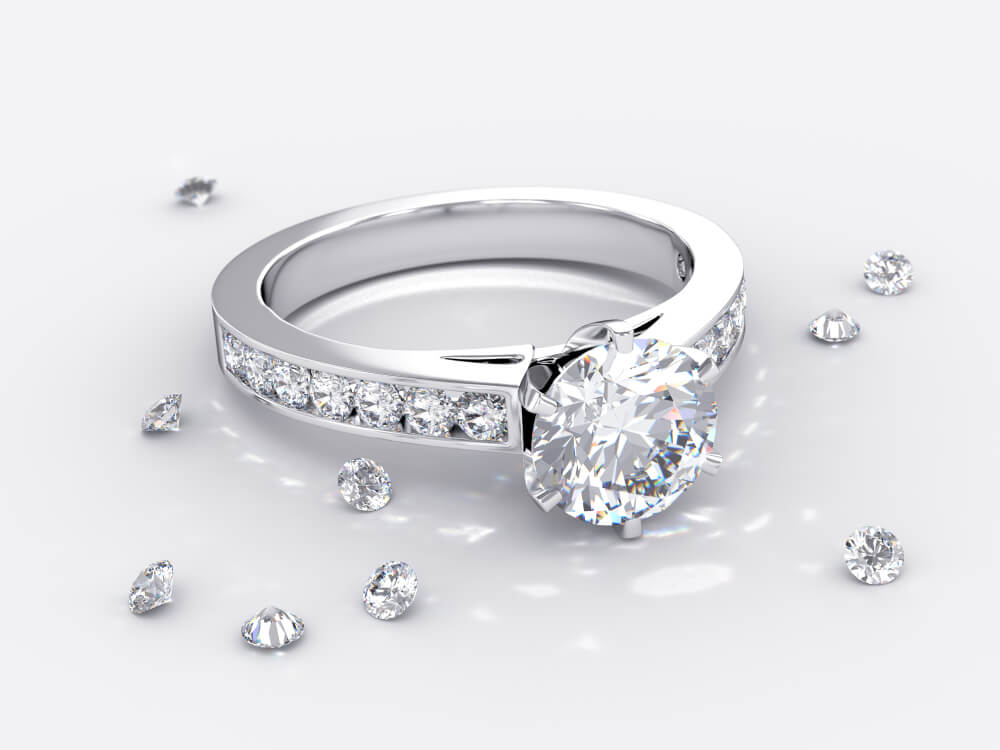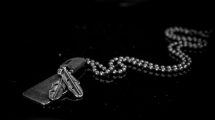As Wedding Know How editors, we write about things that we love and we think you'll like too. We have affiliate partnerships and sponsorship and may generate some revenue from these at no cost to you.
Although a lot of attention is given to the center stone, the setting is equally important in bringing out the beauty of the center stone and providing a platform for it to shine. One setting that does just this is the channel.
The channel setting adds brilliance and depth to an engagement ring design, accentuating the center stone while adding complexity to the band. It’s beautiful enough to stand on its own and makes for excellent wedding rings but when paired with a diamond or gemstone, it shines (pun intended).
Let’s take a look at what the channel setting is all about and how to choose one in this guide.
What is the Channel Setting?
The channel setting is very similar to the pave setting in that it decorates your ring with a line of small diamonds or other gemstones that goes along the ring’s shank. This setting is intended to make your ring beautiful and sparkly without replacing or overshadowing the center stone.

How the Channel Setting Holds the Diamond Melees
The difference between the channel setting and the pave setting is that with the channel setting these smaller diamonds or gemstones aren’t placed on top of the ring’s shank but inside a channel that’s incorporated into the shank. This makes for a more contemporary look but, more importantly, it also serves to protect these smaller gemstones from damage as they are protected by the channel they’re in.
The channel setting isn’t exclusive to engagement rings and can even be used without a centerpiece diamond in eternity bands such as this platinum eternity ring. In engagement rings, however, the purpose of the channel setting is to accent and compliment the centerpiece stone and lead the eye towards it.

Channel set engagement ring. Check price here.
As for the channel itself, more often than not the channel is made to rise just a little bit above the stones in the setting in order to protect them. However, the channel walls can also be made to be level with the stones inside them or slightly lower than them, allowing them to stick out a bit more.
Design and Styles of Channel Settings
Considering that the channel setting is essentially an inclusion inside of the ring’s shank, it can go very well with various ring designs and other setting styles. For example, you can pair a channel set ring with a halo setting which results in a highly brilliant and elaborate design, like this extravagant floral halo setting ring.

Engagement ring with halo and channel setting. See this here.
Most channel setting engagement rings you’re going to see tend to use just prongs for their centerpiece stones, however, because the channel setting offers more than enough eye-catching sparkle to the ring for it to need anything else.
The length of the channel is optional depending on your preferred style as well as your budget. You can have channel settings that are very short, like this one and barely extend from the centerpiece stone or channel settings that go halfway or two thirds across the ring, like this ring.

Bow-tie channel set engagement ring. Check price here.
You can also have more stylized channels like the bow-tie ring featured above. These incorporate the concept of the channel setting with stylistic features.
As for what types of stones you can have inside the channel setting, the most common choice is smaller diamonds but you can really put any gemstone there, as long as it goes well with the ring’s metal color, style, and centerpiece stone, like this sapphire plus diamonds classic channel ring, for example.
What’s the Right Diamond Shape for A Channel Setting?
The diamonds that go into the setting are typically single cut, meaning that they have 17 or 18 facets instead of the 57 or 58 facets a full cut round centerpiece diamond will have. Those 17 to 18 facets are more than enough for these small stones, however, as they give them the necessary brilliance and sparkle to make the channel setting truly spectacular.
The reason these melee diamonds aren’t usually full cut is simply because it’s unnecessary as the results of the full cut would be wasted on such small stones that are largely hidden inside a metal channel.
As for the centerpiece diamond, you can opt for any size, shape and cut diamonds as center stones for a channel setting engagement ring. The channel doesn’t negatively impact on the look of the center stone if carefully chosen, as its purpose is to highlight the stone and complement it.
Why and How to Choose A Channel Setting?

The reason you should consider a channel setting is pretty obvious – it’s a gorgeous ring design. It makes the center diamond pop out without overshadowing it, it enhances the ring’s sparkle from all sides, it has a modern and fresh look, and it doesn’t compromise the integrity and durability of the ring.
As for how you should choose the right channel setting, the key here is to pick the right length, depth, width, and channel stones that compliments the overall ring style and design.
If the center stone isn’t very large, opt for a thinner channel or a shorter length to avoid overshadowing it. Combining a channel setting with a halo setting is a good choice in such a situation, as it makes the stone look larger than it is.
As long as you don’t compromise the look of your center stone, the rest is pretty much subjective and all you need to do is browse through enough types of channels to find the one that you like the most.
One thing to note is that resizing a full channel setting can be difficult and jewelers may not undertake the task. It’s important to get the size of your finger right on the first go. Check with your jeweler before you purchase to make sure there are no nasty surprises later.
How to Clean A Channel Setting?
One of the key drawbacks of a channel setting is that it requires quite a bit of cleaning. The channel is an excellent place for dirt and dust to accumulate in and it’s also very difficult to clean manually without having to remove the setting’s stones.

The way around that is to both reduce the exposure to dirt by removing the ring during manual labor, as well as to clean it more frequently.
Regular cleaning will wash away the dust and dirt before they’ve lodged too stubbornly inside the channel. Simply using warm water with mild soap should be enough if it’s done periodically.
Aside from that, an annual trip to a jeweler for a professional cleanup is also strongly recommended if you want your ring to last for as long as possible.
Pros and Cons of the Channel Setting
To summarize, here are the main pros and cons of the channel engagement ring setting:
Pros:
- It makes the entire ring sparkle beautifully in tandem with the centerpiece diamond.
- The channel protects the smaller stones from snagging on clothing or from getting hit.
- The channel setting is a beautiful and contemporary design that can turn any plain ring into a captivating masterpiece.
- It doesn’t compromise the structural integrity of the ring.
Cons:
- This setting is quite difficult to clean if you’ve skipped doing so for a while. Regularly washing channel engagement rings is a must.
- Resizing and repairing a channel set engagement ring can be challenging because of the channel and all the stones in it.









